Photograph:
Beech Queen Air 70 VH-CLH (c/n LB-20) of Masling Airlines at Bankstown, NSW (David C Eyre)
Country of origin:
United States of America
Description:
Business and executive aircraft / commuter airliner
Power Plant:
Two 254 kw (340 hp) Lycoming IGSO-480-A1E6 six-cylinder horizontally-opposed air-cooled engines
Specifications:
- Wingspan: 13.98 m (45 ft 10½ in)
- Length: 10.16 m (33 ft 4 in)
- Height: 4.34 m (14 ft 3 in)
- Wing area: 25.73 m² (277 sq ft)
- Max speed at 3,658 m (12,000 ft): 385 km/h (239 mph)
- Max cruising speed at 4,572 m (15,000 ft): 344 km/h (214 mph)
- Economical cruising speed: 275 km/h (121 mph)
- Initial rate of climb: 396 m/min (1,300 ft/min)
- Service ceiling: 9,540 m (31,300 ft)
- Max fuel range with 45 mins reserve: 1,963 km (1,220 miles)
- Empty weight: 2,130 kg (4,695 lb)
- Loaded weight: 3,493 kg (7,700 lb)
History:
The first large twin-engine aircraft built by the Beechcraft Corporation, the Queen Air series of aircraft was introduced to the Company’s range in 1958. The first version produced was the Model 65, with up-swept vertical tail surfaces and 254 kw (340 hp) Lycoming IGSO-480-A1A6 engines. This was followed into production by the A65, which was fitted with the same engine but had swept-back vertical tail surfaces. This feature became standard on all Queen Airs subsequently produced.
A further development, the Model 80, introducing the 283 kw (380 hp) Lycoming IGSO-540-A1A engine, was flown for the first time on 22 June 1961. In January 1964 the Model A80 appeared with the same engine as the Model 80, but with an extended wing to permit a higher gross weight.
Development continued, with increases in engine power, and therefore gross weight. The Model B80 was introduced with the 283 kw (380 hp) IGSO-540 engine, and the Model 70 which had lower power engines but had the larger wing which had been introduced on the A80.
A Queen Air established a class altitude in 1960 of 10,632 m (34,882 ft).
When production of the Models 65 and 70 was concluded in 1971, some 404 Model 65s and 42 Model 70s had been completed. One of the last models was the Model 88, a pressurised version of the Model 80.
In 1971 the Excalibur Aviation Company and Swearingen Aircraft acquired the rights to build and market a modified version of the Queen Air. Described as the Queen Air 800, it had 298 kw (400 hp) Lycoming IO-720 eight-cylinder air-cooled engine, low-drag engine nacelles, and three-blade Hartzell propellers.
In the business and executive role, the Queen Air accommodated a maximum of eight persons, including the pilot, but as a commuter aircraft, for which it was used for many years in Australia by Masling Airlines, and later by Southern Cross Airlines, it accommodated a pilot and seven to nine passengers.
A number of Queen Airs have appeared on the Australian register over the years, and the type was operated by the New South Wales Ambulance Service and the Flying Doctor Service in Queensland.
Three were used by Trans Australia Airlines (TAA – later Australia Airlines) in northern Queensland on routes which later were taken over by commuter airlines, these entering service in 1963. TAA later obtained further Queen Airs, the first of these aircraft VH-TGA (c/n LD152 – ex N6868Q), a Model A80 Mk 2, being handed over to Trans Australia Airlines at a ceremony in August 1964 at Essendon, VIC. These aircraft had been modified by Hawker de Havilland to take ten passenger seats with a toilet, room for a small quantity of mail and freight, the electronics being removed from the nose and the nose locker area being extended. The first aircraft began services in Tasmania, replacing an earlier model Queen Air which had been chartered from Thiess Bros Pty Ltd in order to inaugurate the Tasmanian intra-state services. The disposable load of the A80 was 1,642 kg (3,620 lb).
By the end of 1986 there were still 25 examples of the Queen Air on the Australian Civil Aircraft Register, and in fact ways and means of extending the life of the type were looked at. During 1986 Hawker Pacific announced it was offering Excalibur conversion of the Queen Air, modifications to be performed at Bankstown, NSW. This modification, developed in the USA, has been referred to above, and the first Australian conversion was completed in 1986.
One of the NSW Ambulance Board Queens Airs VH-AMB (c/n LD320) has been restored and placed on display at the Power House Museum in Sydney, NSW; and another for a time was on display at Essendon, VIC with “Essendon Market” painted on the nose. An ex-RFDS Queen Air has been displayed at the Stockmans Hall of Fame at Longreach, QLD.
In New Zealand one B80 Excalibur 8800 variant ZK-SFC (c/n LD-502 – ex VH-UQA, TR-LUK) was operated by Skyferry on the Wellington to Blenheim route; and in the mid 1990s Paul Muller Aircraft Ltd of New Plymouth imported three Queen Airs for refurbishment, two for Kiwi West, comprising an A80-800 ZK-TIK (c/n LD-249 – ex VH-NQU, VH-NAU, N61DE, N610JD, N211CC, N515D) and a B80 ZK-TAK (c/n LD-324 – ex ZS-KJK, N7848L), being later painted in Air Raratonga markings. An ex US Army model became ZK-TOE (ex N5079G).
Only a few examples of the series survive.

